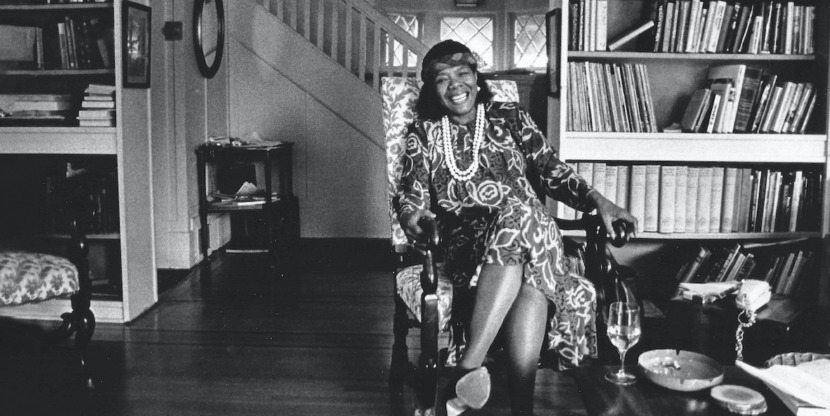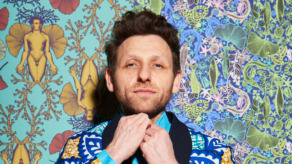The inspiring life of Maya Angelou

When she was a little girl, Maya Angelou discovered that her words could have big consequences. She would continue to use her voice throughout her life: “The idea is to write it so that people hear it and it slides through the brain and goes straight to the heart.”
[…] And then Guy, her son, was born—”beautiful and completely mine,” as she described him. To take care of him, Maya took on any work she could get. She danced barefoot in bars, flipped burgers in a fast food restaurant and even removed paint from cars with her bare hands. At 1.8-meters tall, and often dressed in traditional African clothes, she was striking to look at.
For a short while, she was married to a Greek sailor, Tosh Angelos, a man who, in Maya’s words, “had read as much as I had read”. She later recalled that, “I’ve always been a patsy for men who can think”. When this marriage ended, Maya kept Angelos’ surname and from then on she was Maya Angelou. She joined the Porgy and Bess show as a dancer and traveled through the US and Europe, sometimes not seeing her son for months on end. Nevertheless their bond was tight. “I didn’t grow up in her shadow, but in her light,” Guy said, looking back.
Maya’s writing ambitions took her to New York, where she joined the Harlem Writers Guild. Inspired by Martin Luther King’s message of non-violence, she became a coordinator in one of the organizations he founded. She also became involved with the emerging civil rights movement and fell in love with South African freedom fighter Vusumzi Make. They married and went to live in Cairo, Egypt, but they soon separated: An independent American woman and a traditional African man did not go well together.
Guy went to study in Ghana, one of the independent states that many black Americans gravitated to in that time. He got into a serious car accident and was injured so badly that his life was in danger. Maya rushed to be with him and, miraculously, Guy survived. To stay close to him, Maya decided to move to Accra and work at the university. It was an exhilarating time, full of heated discussions, parties and a hope for a better future.
During that time, Maya met, and was inspired by, Malcolm X and decided to return to the US to help him set up his Organization of Afro-American Unity. But in 1965, he was assassinated, and three years later, King was killed, too. King’s murder took place on Maya’s 40th birthday: April 4, 1968. For years, she did not celebrate that day. She was in a state of shock. Precious little remained of all the euphoria and hope that had been alive earlier that decade.
Nevertheless, she kept her good humor and remained a great raconteur. Friends of Maya were so impressed with her fascinating tales that they called a publisher to tip him off that she ‘told the best stories […] she’s got a book in her’. The editor called her to propose that she write a book about her life. She refused the offer: Her heart lay more with poetry and theater.
After months of hounding her to no avail, the editor finally challenged Maya by saying that that ‘to write an autobiography as literature would be almost impossible’. It turned out that this was the right approach, as Maya took the bait. Her 1969 autobiography I know why the caged bird sings became an incredible success. This eminently literary story of a black woman’s life, in which she describes in plain terms what it is like to grow up as a black girl in the racist south of the US, was the book that many had been waiting for. Now other black women also dared to come forward with their experiences of abuse, poverty and teenage pregnancy—and how they survived.
Standing Ovation
Maya was famous now. She continued to engage in a wide range of activities: She acted (she played Kunta Kinte’s grandmother in the first all-black TV series Roots in 1977), she recited her poetry on stage as a performer, and was a lecturer at a university. And of course she continued to write, producing poetry as well as six more autobiographical books. “The idea is to write it so that people hear it and it slides through the brain and goes straight to the heart,” she said.
During this period she wrote one of her most famous and still frequently quoted poems: ‘Still I Rise’. It was also a happy time in her personal life. She had a relationship with Paul du Feu, a Welsh carpenter and ex-husband of fellow feminist Germaine Greer. They fixed up houses, threw parties and drank more than was good for them. From the outside, it all looked fantastic, but in 1981 Maya left Paul; perhaps she was not made for long-term relationships.
Now, she was more than a writer or an actress: she was a ‘phenomenal woman’, as she describes herself in her famous poem of the same name (and there’s no mistake about it; others wholeheartedly agreed). She was a role model and someone who was listened to. ‘Rarely did we ever have a phone conversation during which I didn’t take notes,’ writes Oprah Winfrey, who considered herself an adopted daughter of Maya’s, in her preface to an edition of I know why the caged bird sings.
Then-US President Bill Clinton asked Maya to write an inaugural poem and to read it at his inauguration in 1993. Despite being a white man, he also identifies with her book: Stamps is very near to where he grew up. After the inauguration, he said he knew she would make an impression as she had a striking presence and had the voice of God.
After that performance, Maya was not only famous in the US but all around the world. She became a popular guest on TV shows, from Sesame street to the Oprah Winfrey show, where she spoke compassionately about language, racism, sexism and self-esteem. She knew what she was worth. When strangers call her ‘Maya’, she responded with a gentle but immediate correction: She is Dr. Angelou.
Writing and performing continued to be her life, right up until the end of her life. She was unstoppable. Toward the end, she had to go on stage in a wheelchair and with extra oxygen, but she still went, until it really became physically impossible. She died on May 28, 2014. At a memorial service, the then-First Lady Michelle Obama, whose husband had presented Maya with the prestigious Presidential Medal of Freedom in 2011, said: “She touched people all across the globe, including a young white woman from Kansas who named her daughter after Maya, and raised her son to be the first black President of the United States”.
- The complete story about Maya Angelou can be found in Issue 36.
Text Liddie Austin Photography Getty Images







